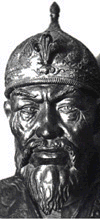Mongol invasions of India
The Mongol Empire launched several invasions into the Indian subcontinent from 1221 to 1327, with many of the later raids made by the Qaraunas of Mongol origin. The Mongols occupied parts of the subcontinent for decades. As the Mongols progressed into the Indian hinterland and reached the outskirts of Delhi, the Delhi Sultanate led a campaign against them in which the Mongol army suffered serious defeats.[1]
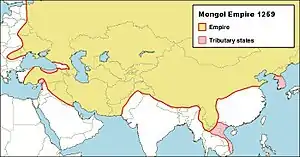
The Mongol invasions brought many massacres and atrocities to the Indian subcontinent, but its rule was mostly limited to Western Pakistan. On occasion, Mongols extended their rule in Eastern Pakistan and areas bordering Northern India but never further than Dehli. The Mongols also ruled Kashmir from 1235 to 1305.[2] The Mongols invaded Lahore, Pakistan, with an army of 30,000. They massacred most of its inhabitants and ruled the territory from 1241 until 1266 when Sultan Balban reconquered the region. Lahore would return to Mongol rule again in 1287.[3][4] From 1296 to 1305, Mongols overran and occupied Punjab, again committing atrocities against the locals. The Mongols invaded Sindh province later marching towards Delhi, where they ransacked and massacred the inhabitants. The Mongols briefly occupied the city, but were quickly defeated by Malik Kafur, one of the Sultan's generals. Numerous Mongol invasions followed, mostly within North India, but the Mongols were ultimately forced to withdrawal in the wake of several defeats at the hands of Delhi.
Background
After pursuing Jalal ad-Din into India from Samarkand and defeating him at the battle of Indus in 1221, Genghis Khan sent two tumens (20,000 soldiers) under commanders Dorbei the Fierce and Bala to continue the chase. The Mongol commander Bala chased Jalal ad-Din throughout the Lahore region and attacked outlying province Multan, and even sacked the outskirts of Lahore. Jalal ad-Din regrouped, forming a small army from survivors of the battle and sought an alliance, or even an asylum, with the Turkic rulers of Delhi Sultanate, but was turned down.[5]
Jalal ad-Din fought against the local rulers in Punjab. After being defeated by many of them in the open, he retreated to the outskirts of Punjab seeking refuge in Multan.
While fighting against the local governor of Sindh, Jalal ad-Din heard of an uprising in the Kirman province of southern Iran and he immediately set out for that place, passing through southern Baluchistan on the way. Jalal ad-Din was also joined by forces from Ghor and Peshawar, including members of the Khalji, Turkoman, and Ghori tribes. With his new allies he marched on Ghazni and defeated a Mongol division under Turtai, which had been assigned the task of hunting him down. The victorious allies quarreled over the division of the captured booty; subsequently the Khalji, Turkoman, and Ghori tribesmen deserted Jalal ad-Din and returned to Peshawar. By this time Ögedei Khan, third son of Genghis Khan, had become Great Khan of the Mongol Empire. A Mongol general named Chormaqan sent by the Khan attacked and defeated Jalal ad-Din, thus ending the Khwārazm-Shāh dynasty.[6]
Mongol conquest of Kashmir
Some time after 1235 another Mongol force invaded Kashmir, stationing a darughachi (administrative governor) there for several years, and Kashmir became a Mongolian dependency.[7] Around the same time, a Kashmiri Buddhist master, Otochi, and his brother Namo arrived at the court of Ögedei. Another Mongol general named Pakchak attacked Peshawar and defeated the army of tribes who had deserted Jalal ad-Din but were still a threat to the Mongols. These men, mostly Khaljis, escaped to Multan and were recruited into the army of the Delhi Sultanate. In winter 1241 the Mongol force invaded the Indus valley and besieged Lahore. However, on December 30, 1241, the Mongols under Munggetu butchered the town before withdrawing from the Delhi Sultanate. At the same time the Great Khan Ögedei died (1241).
The Kashmiris revolted in 1254–1255, and Möngke Khan, who became Great Khan in 1251, appointed his generals, Sali and Takudar, to replace the court and appointed the Buddhist master, Otochi, as darugachi of Kashmir. However, the Kashmiri king killed Otochi at Srinagar. Sali invaded Kashmir, killing the king, and put down the rebellion, after which the country remained subject to the Mongol Empire for many years.[8]
Intrusion into Delhi Sultanate
The Delhi prince, Jalal al-Din Masud, traveled to the Mongol capital at Karakorum to seek the assistance of Möngke Khan in seizing the throne from his elder brother in 1248. When Möngke was crowned as Great Khan, Jalal al-Din Masud attended the ceremony and asked for help from Möngke. Möngke ordered Sali to assist him to recover his ancestral realm. Sali made successive attacks on Multan and Lahore. Sham al-Din Muhammad Kart, the client malik (ruling prince) of Herat, accompanied the Mongols. Jalal al-Din was installed as client ruler of Lahore, Kujah and Sodra. In 1257 the governor of Sindh offered his entire province to Hulagu Khan, Mongke's brother, and sought Mongol protection from his overlord in Delhi. Hulagu led a strong force under Sali Bahadur into Sindh. In the winter of 1257 - beginning of 1258, Sali Noyan entered Sind in strength and dismantled the fortifications of Multan; his forces may also have invested the island fortress of Bakhkar on the Indus.
But Hulagu refused to sanction a grand invasion of the Delhi Sultanate and a few years later diplomatic correspondence between the two rulers confirmed the growing desire for peace.
Ghiyas ud din Balban's (reigned: 1266–1287) one absorbing preoccupation was the danger of a Mongol invasion. For this cause he organized and disciplined his army to the highest point of efficiency ; for this he made away with disaffected or jealous chiefs, and steadily refused to entrust authority to Hindus; for this he stayed near his capital and would not be tempted into distant campaigns.[9]
Large-scale Mongol invasions of India ceased and the Delhi Sultans used the respite to recover the frontier towns like Multan, Uch, and Lahore, and to punish the local Ranas and Rais who had joined hands with either the Khwarazim or the Mongol invaders.
Chagatai Khanate-Dehlavi Wars
Transformation of the Delhi Sultanate
There was a rapid change in the balance of power in Northern India as power violently shifted from the Turkic nobles to a new Indo-Mussalman nobility.[10] A khalji family, who had migrated a century ago to India by accompanying Ghori,[11] would identify themselves with the Indian Muslims, and their khalji and Indo-Muslim faction would grow in strength due to the rising number of converts.[12][13] With a series of assassinations, they would finally usurp the throne in 1290 and appoint their Indo-Muslim allies such as Zafar Khan (Minister of War),[14] Nusrat Khan (Wazir of Dehli),[15][16] Ayn al Mulk Multani,[17] Malik Karfur, Malik Tughlaq,[18] and Malik Nayk(Master of the Horse)[19] who were famous warriors but non-Turks, which resulted in the emergence of an Indo-Muslim state. The changes during this period allowed for rapid Dehlavi conquests into the rest of India.[20][21] At about this time the Mongol raids into India were also renewed (1300)
Rise of the Chagatais
After civil war broke out in the Mongol Empire in the 1260s, the Chagatai Khanate controlled Central Asia and its leader since the 1280s was Duwa Khan who was second in command of Kaidu Khan. Duwa was active in Afghanistan, and attempted to extend Mongol rule into India. The medieval sources claim invasions by hundreds of thousands of Mongols, numbers approximating (and probably based on) the size of the entire cavalry armies of the Mongol realms of Central Asia or the Middle East: about 150,000 men. A count of the Mongol commanders named in the sources as participating in the various invasions might give a better indication of the numbers involved, as these commanders probably led tumens, units nominally of 10,000 men.[22] These invasions were led by either various descendants of Genghis Khan or by Mongol divisional commanders; the size of such armies was always between 10,000-30,000 cavalry although the chroniclers of Delhi exaggerated the number to 100,000-200,000 cavalry.[23]
The Muslim Negudari governor Abdullah, who was a son of Chagatai Khan's great grandson,[24] invaded Punjab with his force in 1292, but their advance guard under Ulghu was defeated and taken prisoner by the Khalji Sultan Jalaluddin. The 4000 Mongol captives of the advance guard converted to Islam and came to live in Delhi as "new Muslims". The suburb they lived in was appropriately named Mughalpura.[25][26] Chagatai tumens were beaten by the Delhi Sultanate several times in 1296–1297.[27]
Battle of Jaran-Manjur
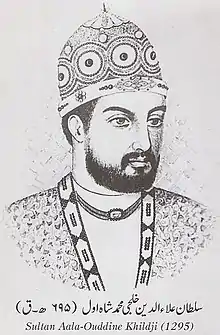
Unlike the previous invasions, the invasions during the reign of Jalaluddin's successor Alauddin were major Mongol conquests. In the winter of 1297, the Chagatai noyan Kadar led an army that ravaged the Punjab region, and advanced as far as Kasur.[28] Alauddin's army, led by Ulugh Khan and probably Zafar Khan defeated the invaders on the Battle of Jaran-Manjur on 6 February 1298 [28] where quite a large number of them were taken prisoner.
Siege of Sehwan
Later in 1298–99, a Mongol army (possibly Neguderi fugitives) invaded Sindh, and occupied the fort of Sivistan.[29] These Mongols were defeated by Zafar Khan: a number of them were arrested and brought to Delhi as captives.[30] At this time, the main branch of Alauddin's army, led by Ulugh Khan and Nusrat Khan was busy raiding Gujarat. When this army was returning from Gujarat to Delhi, some of its Mongol soldiers staged a mutiny over payment of khums (one-fifth of the share of loot).[31] The mutiny was crushed, and the mutineers families in Delhi were severely punished.[32]
Battle of Killi
In late 1299, Duwa dispatched his son Qutlugh Khwaja to conquer Delhi.[33] Alauddin led his army to Kili near Delhi, and tried to delay the battle, hoping that the Mongols would retreat amid a scarcity of provisions and that he would receive reinforcements from his provinces. However, his general Zafar Khan attacked the Mongol army without his permission.[34] The Mongols feigned a retreat, and tricked Zafar Khan's contingent into following them. Zafar Khan and his men were killed after inflicting heavy casualties on the invaders.[35] The Mongols retreated a couple of days later: their leader Qutlugh Khwaja was seriously wounded, and died during the return journey.[36]
Siege of Delhi
In the winter of 1302–1303, Alauddin dispatched an army to ransack the Kakatiya capital Warangal, and himself marched to Chittor. Finding Delhi unprotected, the Mongols launched another invasion around August 1303.[37] Alauddin managed to reach Delhi before the invaders, but did not have enough time to prepare for a strong defence. He took shelter in a heavily-guarded camp at the under-construction Siri Fort. The Mongols ransacked Delhi and its neighbourhoods, but ultimately retreated after being unable to breach Siri.[38] This close encounter with the Mongols prompted Alauddin to strengthen the forts and the military presence along their routes to India.[39] He also implemented a series of economic reforms to ensure sufficient revenue inflows for maintaining a strong army.[40]
Shortly afterward, Duwa Khan sought to end the ongoing conflict with the Yuan Khagan Temür Öljeytü, and around 1304 a general peace among the Mongol khanates was declared, bringing an end to the conflict between the Yuan Dynasty and western khanates that had lasted for the better part of a half century. Soon after, he proposed a joint attack on India, but the campaign did not materialize.
Battle of Amroha
In December 1305, Duwa sent another army that bypassed the heavily guarded city of Delhi, and proceeded south-east to the Gangetic plains along the Himalayan foothills. Alauddin's 30,000-strong cavalry, led by Malik Nayak, defeated the Mongols at the Battle of Amroha.[41][42] A large number of Mongols were taken captive and killed.[43]
Battle of Ravi (1306)
In 1306, another Mongol army sent by Duwa advanced up to the Ravi River, ransacking the territories along the way. This army included three contingents, led by Kopek, Iqbalmand, and Tai-Bu. Alauddin's forces, led by Malik Kafur, decisively defeated the invaders.[44]
Dehlavi counteroffensives
In that same year the Mongol Khan, Duwa, died and in the dispute over his succession this spate of Mongol raids into India ended. Taking advantage of this situation, Alauddin's general Malik Tughluq regularly raided the Mongol territories located in present-day Afghanistan.[45][46]
Late Mongol invasions
In 1320 the Qaraunas under Zulju (Dulucha) entered Kashmir by the Jehlam Valley without meeting any serious resistance. The Kashmiri king, Suhadeva, tried to persuade Zulju to withdraw by paying a large ransom.[47] After he failed to organize resistance, Suhadeva fled to Kishtwar, leaving the people of Kashmir to the mercy of Zulju. The Mongols burned the dwellings, massacred the men and made women and children slaves. Only refugees under Ramacandra, commander in chief of the king, in the fort of Lar remained safe. The invaders continued to pillage for eight months until the commencement of winter. When Zulju was departing via Brinal, he lost most of his men and prisoners due to a severe snowfall in Divasar district.
The next major Mongol invasion took place after the Khaljis had been replaced by the Tughlaq dynasty in the Sultanate. In 1327 the Chagatai Mongols under Tarmashirin, who had sent envoys to Delhi to negotiate peace the previous year, sacked the frontier towns of Lamghan and Multan and besieged Delhi. The Tughlaq ruler paid a large ransom to spare his Sultanate from further ravages. Muhammad bin Tughluq asked the Ilkhan Abu Sa'id to form an alliance against Tarmashirin, who had invaded Khorasan, but an attack didn't materialize.[48] Tarmashirin was a Buddhist who later converted to Islam. Religious tensions in the Chagatai Khanate were a divisive factor among the Mongols.
No more large-scale invasions or raids into India were launched after Tamashirin's siege of Delhi. However, small groups of Mongol adventurers hired out their swords to the many local powers in the northwest. Amir Qazaghan raided northern India with his Qara'unas. He also sent several thousand troops to aid the Delhi Sultan Muhammad bin Tughluq in suppressing the rebellion in his country in 1350.
Timur and Babur
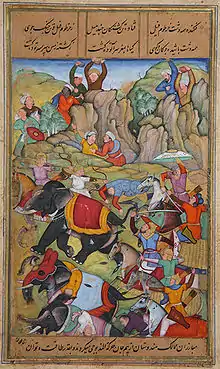
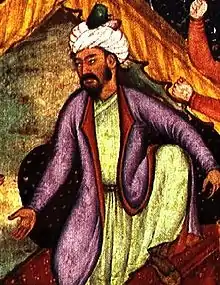
The Delhi sultans had developed cordial relations with the Yuan dynasty in Mongolia and China and the Ilkhanate in Persia and the Middle East. Around 1338, Sultan Muhammad bin Tughluq of the Delhi Sultanate appointed Moroccan traveler Ibn Battuta an ambassador to the Yuan court under Toghon Temür (Emperor Huizong). The gifts he was to take included 200 slaves.
The Chagatai Khanate had split up by this time and an ambitious Mongol Turk chieftain named Timur had brought Central Asia and the regions beyond under his control. He followed the twin policies of Imperialism and Islamization, shifting various Mongol tribes to different parts of his empire and giving primacy to the Turkic people in his own army. Timur also reinforced the Islamic faith over the Chagatai Khanate and gave primacy to the laws of the Shari'ah over Genghis Khan's shamanist laws. He invaded India in 1398 to make war and plunder the wealth of the country.
Timur's empire broke up and his descendants failed to hold on to Central Asia, which split up into numerous principalities. The descendants of the Mongol Chagtais and the descendants of Timur empire lived side by side, occasionally fighting and occasionally inter-marrying.
One of the products of such a marriage was Babur, founder of the Mughal Empire.[49] His mother belonged to the family of the Mongol Khans of Tashkent. Babur was a true descendant of Timur and shared his beliefs: he believed that rules and regulations of Genghis Khan were deficient as he remarked, "they had no divine authority."
Even though his own mother was a Mongol, Babur was not very fond of the Mongol race and wrote a stinging verse in his autobiography:
- "Were the Mughals an angel race, it would be bad,
- Even write in gold, the Mughal name would be bad."
When Babur occupied Kabul and began invading the Indian subcontinent, he was called a Mughal like all the earlier invaders from the Chagatai Khanate. Even the invasion of Timur had been considered a Mongol invasion since the Mongols had ruled over Central Asia for so long and had given their name to its people.
See also
- India-Mongolia relations
References
- Herbert M. J. Loewe. The Mongols.
- An Era not recorded by Kashmiri Chroniclers;Mongol rule in Kashmir from 1235 to 1305 CE https://www.academia.edu/33160219/An_Era_not_recorded_by_Kashmiri_Chroniclers_Mongol_rule_in_Kashmir_from_1235_to_1305_CE
- Indo-Persian Historiography Up to the Thirteenth Century
- The Dancing Girl: A History of Early India
- Gilmour, James (n.d.). Among the Mongols. Boston University School of Theology. London, Religious Tract Society.
- Chormaqan Noyan: The First Mongol Military Governor in the Middle East by Timothy May
- Thomas T. Allsen-Culture and Conquest in Mongol Eurasia, p.84
- André Wink-Al-Hind, the Making of the Indo-Islamic World, p.208
- Lane-Poole, Stanley (March 2019). Medieval India: Under Mohammedan Rule (A.D. 712-1764). Alpha Editions. ISBN 9789353601669.
- Mohammad Aziz Ahmad (1939). "The Foundation of Muslim Rule in India. (1206-1290 A.d.)". Proceedings of the Indian History Congress. Indian History Congress. 3: 832–841. JSTOR 44252438.
- 5 Books Combined Old NCERT Histroy Manual Series for Civil Services Examination by DP Format: Mocktime Publication. Mocktime Publications. January 0101.
- Jaswant Lal Mehta (1979). Advanced Study in the History of Medieval India, Volume 2. Sterling Publishers Pvt. Ltd. ISBN 9788120706170.
- Mohammad Aziz Ahmad (1939). "The Foundation of Muslim Rule in India. (1206-1290 A.d.)". Proceedings of the Indian History Congress. Indian History Congress. 3: 832–841. JSTOR 44252438.
- Satish Chandra (2004). Medieval India: From Sultanate to the Mughals-Delhi Sultanat (1206-1526). Har-Anand Publications. p. 269. ISBN 9788124110645.
- Yasin Mazhar Siddiqi (1972). "the Kotwals under the Sultans of Delhi". Indian History Congress: 194. JSTOR 44145331.
Nusrat Khan Jalesari who was the Kotwal in the first year of the Alai reign was an Indian Muslim
Cite journal requires|journal=(help) - The Life and Works of Sultan Alauddin Khalji. Atlantic Publishers & Dist. 1992. ISBN 9788171563623.
the Sultan appointed his Wazir Nusrat Khan to deal with the Jalali nobles...Nusrat Khan confiscated property worth about one crore. This brought to an end the influence of the Jalali nobles and strengthened the government trreasury. Also the Sultan got a happy riddance from a nobility, whose loyalty was always doubtful. After this he created a new nobility whose distinctive feature was its loyalty and friendship of Ala-ud-Din
- SHAIKH ABDUL LATIF (1993). "The Indian Elements in the Bureaucracy of the Delhi Sultanate". Proceedings of the Indian History Congress. Indian History Congress. 54: 159. JSTOR 44142942.
- Fouzia Farooq Ahmed (27 September 2016). Muslim Rule in Medieval India: Power and Religion in the Delhi Sultanate. p. 151. ISBN 9781786730824.
- Kaushik Roy (2003). Warfare in Pre-British India - 1500BCE to 1740CE. Routldge. ISBN 9781317586913.
Malik Naik(a Hindu convert to Islam)
- Satish Chandra (2004). Medieval India: From Sultanate to the Mughals-Delhi Sultanat (1206-1526). Har-Anand Publications. p. 269. ISBN 9788124110645.
It has been suggested that with the rise of the Khaljis, and the end of Turkish monopoly of high offices, an "integrated Indo-Muslim state" emerged in India
- Satish Chandra (2004). Medieval India: From Sultanate to the Mughals-Delhi Sultanat (1206-1526). Har-Anand Publications. p. 86. ISBN 9788124110645.
...internal restructuring of the administration, conditions were created for the rapid territorial expansion of the sultanat
- John Masson Smith, Jr. Mongol Armies and Indian Campaigns.
- John Masson Smith, Jr. Mongol Armies and Indian Campaigns and J.A. Boyle, The Mongol Commanders in Afghanistan and India.
- Rashid ad-Din - The history of World
- Dr. A. Zahoor (21 May 2002). "Muslims in the Indian Subcontinent" (PDF). pp. 58–59. Retrieved 2015-08-20.
- J.A. Boyle, "The Mongol Commanders in Afghanistan and India According to the Tabaqat-I-Nasiri of Juzjani," Islamic Studies, II (1963); reprinted in idem, The Mongol World Empire (London: Variorum, 1977), see ch. IX, p. 239
- Although Muslim historians claimed Mongols were outnumbered and their army ranged from 100,000 to 200,000, their force was not enough to cow down Delhi mamluks in reality. See John Masson Smith, Jr. Mongol Armies and Indian Campaigns.
- Banarsi Prasad Saksena 1992, p. 332.
- Peter Jackson 2003, pp. 219-220.
- Banarsi Prasad Saksena 1992, p. 336.
- Kishori Saran Lal 1950, p. 87.
- Kishori Saran Lal 1950, p. 88.
- Banarsi Prasad Saksena 1992, p. 338.
- Banarsi Prasad Saksena 1992, p. 340.
- Banarsi Prasad Saksena 1992, p. 341.
- Peter Jackson 2003, pp. 221-222.
- Banarsi Prasad Saksena 1992, p. 368.
- Banarsi Prasad Saksena 1992, pp. 369-370.
- Banarsi Prasad Saksena 1992, p. 372.
- Banarsi Prasad Saksena 1992, p. 373.
- Banarsi Prasad Saksena 1992, pp. 392-393.
- Peter Jackson 2003, pp. 227-228.
- Banarsi Prasad Saksena 1992, p. 393.
- Kishori Saran Lal 1950, pp. 171-172.
- Kishori Saran Lal 1950, p. 175.
- Peter Jackson 2003, p. 229.
- Mohibbul Hasan-Kashmir Under the Sultans, p.36
- The Chaghadaids and Islam: the conversion of Tarmashirin Khan (1331-34). The Journal of the American Oriental Society, October 1, 2002. Biran
- "BĀBOR, ẒAHĪR-AL-DĪN MOḤAMMAD – Encyclopaedia Iranica". www.iranicaonline.org. Retrieved 2018-01-30.
Bibliography
- Banarsi Prasad Saksena (1992). "The Khaljis: Alauddin Khalji". In Mohammad Habib and Khaliq Ahmad Nizami (ed.). A Comprehensive History of India: The Delhi Sultanat (A.D. 1206-1526). 5 (Second ed.). The Indian History Congress / People's Publishing House. OCLC 31870180.
- Chormaqan Noyan: The First Mongol Military Governor in the Middle East by Timothy May
- Harold Lamb, Genghis Khan: Emperor of All Men. ISBN 0-88411-798-7
- J.A. Boyle, "The Mongol Commanders in Afghanistan and India According to the Tabaqat-i-Nasiri of Juzjani." Central Asiatic Journal 9 (1964): 235-247. Reprinted in The Mongol World Empire, 1206–1370, edited by John A. Boyle, Variorum Reprints, 1977.
- John Masson Smith, Jr. - Mongol Armies and Indian Campaigns, University of California, Berkeley
- Kishori Saran Lal (1950). History of the Khaljis (1290-1320). Allahabad: The Indian Press. OCLC 685167335.
- Peter Jackson (2003). The Delhi Sultanate: A Political and Military History. Cambridge University Press. ISBN 978-0-521-54329-3.
- René Grousset (1970). The Empire of the Steppes: A History of Central Asia. Rutgers University Press. ISBN 978-0-8135-1304-1.
